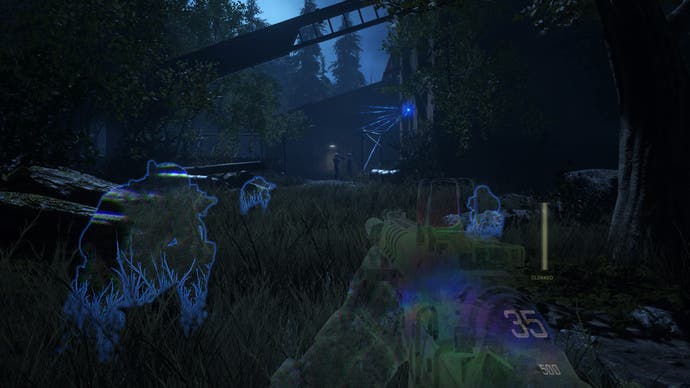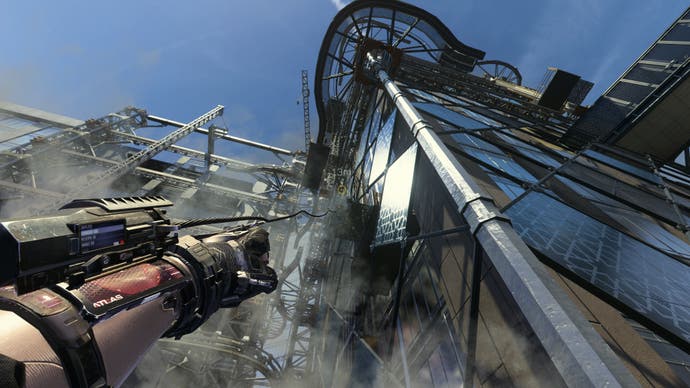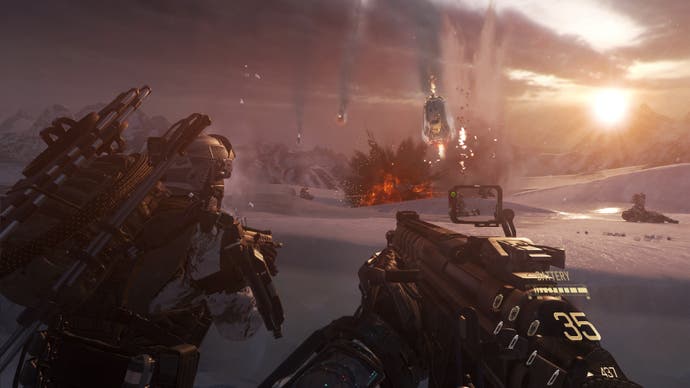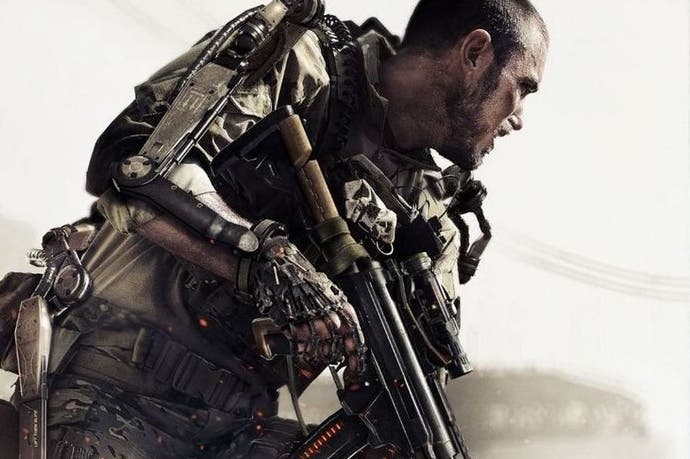Call of Duty: Advanced Warfare review
War never changes.
Every year, Call of Duty gives me an existential crisis. Every year I review the new entry in the series and, every year since Modern Warfare, it's been more or less the same game, barring a few surface changes that only the dedicated fanbase will notice.
How do you define quality in a series like this? I wrestle with this question every November, a personal Autumn tradition now as familiar as Halloween and Bonfire Night. This is a series where the bar has been set high, and consistently met in terms of mechanical competence, but with diminishing returns where creativity is concerned. At what point must the score begin to drop? Is a good game still good after it's been remade ten times over?
At this point, the odds of there being a catastrophically bad Call of Duty game on the core consoles are minimal. Even last year's relatively unpopular Ghosts was solid enough and sold millions. Much as Nando's isn't about to forget how to cook chicken, and Starbucks coffee will always taste the same regardless of what extras get poured in, Activision's many studios know how to make Call of Duty just how you like it. It's less a game franchise at this point, and more a machine of polished predictability. You know what you're getting, and for many that's the appeal.
Advanced Warfare is, supposedly, the game to change that. This is the biggest step forwards for the series in years, we're told. And it's mostly true that, within the narrow confines of a universe where Call of Duty is the only game that exists, Advanced Warfare does introduce ideas that technically haven't been seen before.

In this instance, that means going full sci-fi. Advanced Warfare takes place in the 2050s, by which time we'll not only have soldiers wearing super-powered exoskeletons but bionic limbs, sonic mufflers that hologram communications and those whizzy virtual displays that Tony Stark likes so much, where dragging a file to a USB stick means literally flicking a floating image towards it with your finger.
Through the campaign's 15 missions you'll get to play with a lot of toys - but only when the game's strictly controlled narrative allows you. You'll scale sheer walls using magnetic gloves, race hoverbikes through a flooded Detroit and take down enemies in a rocket and bullet spewing mech suit. But only when the game says you can.
For all the shiny new tech on display, the game beneath is still tethered to the Call of Duty single player formula that has endured since 2003. Lengthy corridor-style shooting galleries are punctuated by big, glossy eye-popping set pieces, doors must periodically be breached in dramatic slow motion and conveniently placed turrets must be manned just as hordes of enemies appear. For all the staged chaos, your role is always an awkward combination of active participant and amateur actor. Like a director with no faith in his cast, the game constantly shoves you into place with rigidly policed mission boundaries, and tells you who to follow, where to go, which way to look, what to do next.
The only time you're given any sort of agency is when the enemies appear, and you get to mow them down. You'll benefit in such situations from brilliant gadgets such as the Threat grenade, which automatically paints all targets in range, but you're still battering your way through the same choke points and checkpoints, occasionally aided by AI squad mates who don't stand up to scrutiny. They'll push you out of the way or walk in front of you as you line up a shot, or else make themselves look busy by shooting in the general direction of the bad guys. Take a break from the carnage to actually watch what is happening on the battlefield and the widescreen illusion falls apart.
In terms of story, too, Advanced Warfare sticks with what has worked in the past. It's another tale of another charismatic madman, holding America (and by default the rest of the planet) to ransom. The key difference this time is that he's played by Kevin Spacey. As Jonathan Irons, head of private military contractor Atlas, Spacey proves to be a distracting presence. No expense has been spared this time on performance capture, so Irons doesn't just sound like Spacey, he looks and moves like him as well. There are moments where the CG is so good that the cutscenes really do rub up against live action, providing you avert your gaze from the lifeless eyes of the cast.

Also sadly devoid of spark is Spacey's performance but then the script doesn't give him much to work with. Even if Irons had been fully fleshed out, he'd still be a stock villain, but the story - streamlined though it may be from the garbled multiple perspectives of previous CODs - has little interest in nuance. One minute Irons is the friendly, supportive head of an enormous multinational army, the next he's the evil mass-slaughtering head of an enormous multinational army. That would probably count as a spoiler, if hadn't been made so blatantly obvious from the very first trailer to feature Spacey's digital face.
Beyond Spacey, none of the other characters stand out. You're playing as a guy called Mitchell, adequately voiced and mo-capped by Troy Baker, but he - and by extension the player - is dramatically inert, a reactor to events rather than a driver of them. There are a handful of squadmates whose names you'll know only because they hover above them when you look in their direction: Gideon. Ilona. Joker. None serves any purpose other than to keep you on mission, and to act as the director's surrogate, prompting you to move forwards through irritable audio loops so the ride can continue.
This has all been true of every game in the series, of course, and it's not as if the recipe doesn't still yield the expected adrenalin-pumping moments. It's a shooting gallery, and shooting galleries are always fun - especially when they're being built to such an established template, and funded to the tune of millions of dollars.
It's just a shame that these recurring weaknesses are apparently seen as such a part of the Call of Duty experience that the shift to new consoles hasn't seen them addressed, or at least made less glaringly obvious. You may, for example, now get to ride a futuristic hoverboat through the glittering canals of New Baghdad, but when the end result is literally no different to the boat chases of Modern Warfare's 2 and 3 in gameplay terms, you realise what a missed opportunity this is. For all the talk of Advanced Warfare's new ideas, very few of them penetrate deeper than surface gloss where single player is concerned.
They do, at least, provide more tangible changes to multiplayer. Here, those exo-suits can be more than just a gimmick, allowing players to boost jump like fleas, and jink left, right and back to dodge fire. Against human foes, rather than the intellectually limited enemies of the campaign, there's actual tactical value to these abilities.

The natural knock-on effect of this is a much needed shake-up in the way maps are designed. Always a very horizontal game, with slippery layouts that keep players churning through the environment few no safe spaces or dead ends, the addition of verticality offers the series its biggest shot in the arm since the first Modern Warfare. Strategies that once allowed players to dominate are up-ended by the fact that enemies can now drop from above, taking an exponentially larger number of routes to each objective.
The game's best maps - such as the Greek rooftops of Terrace and the mountainous Retreat - allow for full use of your exo-enabled agility, and much of the appeal of the game's first week has been seeing players adjusting to the new possibilities opened up by this new upwardly-mobile style of play.
Elsewhere, the changes to multiplayer are more in keeping with past games. The loadout system gets another tweak, returning to Black Ops 2's Pick 10, now expanded to Pick 13. That means you can equip whatever range of gear, accessories, perks, abilities and auxiliary items as you like, provided you don't take more than 13 things.
Scoresteaks now also fall under this system, so if you're the sort of player who struggles to accrue enough points to make use of these powerful events, you can ditch them entirely and put their slots to better use. Some Scorestreaks also enable other players to help out. A bombing run, for example, may call for fellow teammates to jump in and guide one of the warheads to a target, so even players who can't trigger these attacks themselves can experience their use, however briefly. More items than ever - again, including Scorestreaks - can also be customised further, using additional modules that unlock as you level up.
It's a simple, flexible system and it goes some way to smoothing out the disparity between level 50 players who have unlocked everything and newcomers: even the basic kit on offer allows for a variety of useful combinations. It may only be a minor shift to the established order, but it's a welcome one.
So many of the changes to multiplayer benefit from being compared only to previous Call of Duty games, however. Certainly, the new emphasis on jumps and taking the fights to higher ground feel fresh within the context of the series, but can hardly be chalked up as a huge step forward in terms of the genre. It feels wearily obvious to draw a line between Titanfall's parkour-flavoured action and the augmented boost-jumping of Advanced Warfare, but while they feel very different in terms of playstyle, the core ideas are close enough for the point to stand.

More than that, Call of Duty's newfound passion for vertical action will be nothing new to players of Halo, and it's suite of high tech abilities such as shields and cloaking devices has been done before by Crysis, amongst others. Even the sci-fi flourishes in the arsenal - still largely based around the traditional assault rifle, SMG, shotgun, sniper rifle, rocket laucher quintet - have echoes in the likes of Killzone and Resistance.
None of which is to say that Advanced Warfare doesn't do what it does with the same polish and gusto you'd expect, only that after a decade of annual variations, the only way it can still lay claim to being exceptional is to measure itself against its own past. And even then, the needle rarely moves from the centre.
For fans wanting to know if Advanced Warfare is an improvement on the rather flaccid Ghosts, the answer is yes - though not by as much as you might hope. It feels like a more coherent package, with only a rote co-op survival mode to bridge the gap between solo and multiplayer, but the knowledge that another game will be along in exactly 12 months, offering yet another cautious remix of the same basic mechanics, isn't the promise it used to be.
Advanced Warfare, then, is everything you expect from Call of Duty. It's polished, and loud, and bombastic, and as a result it ticks the boxes needed to satisfy the brand's fans. But it's also derivative and unwilling to move away from the safety of formula, except in surface ways. It's certainly not a bad game, at least in terms of core mechanics and functionality, but in terms of praise it only ever feels "good enough" rather than just "good".
The big questions hanging over the series remain, and will continue to do so until the campaigns abandon their stifling linearity, and the multiplayer introduces ideas that can genuinely be called new, not just new to Call of Duty.
Advanced Warfare isn't the game to answer those questions. Much like the soldiers that populate its fiction, what strengths it has come from the technology bolted to the surface while what's inside looks more fragile and vulnerable than ever.









